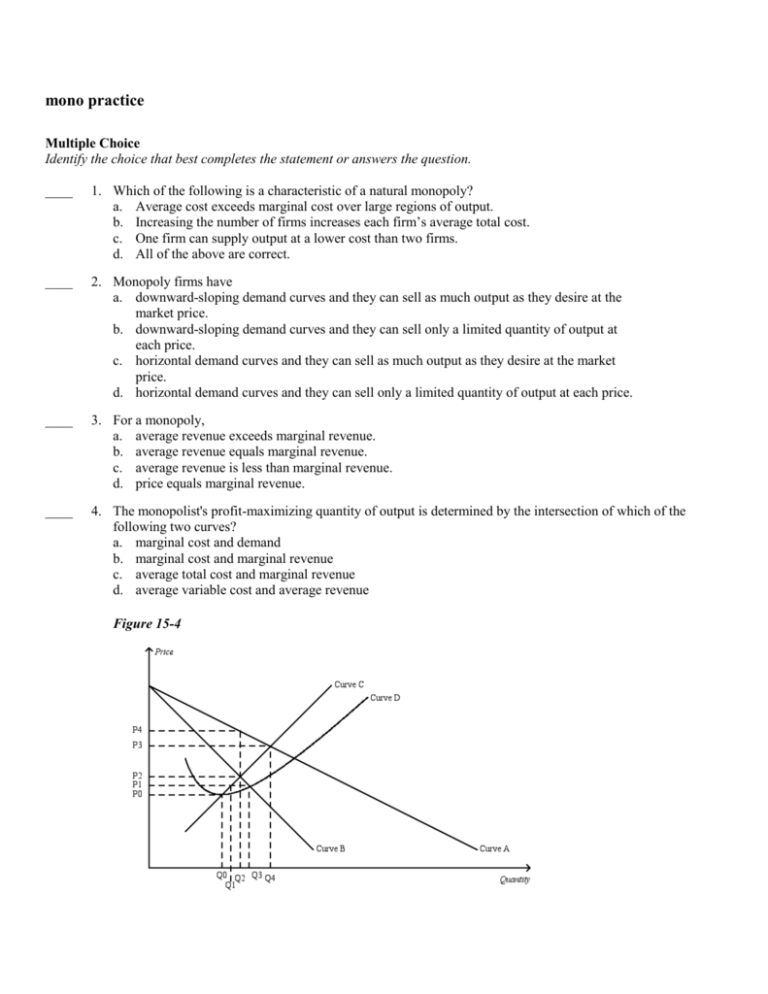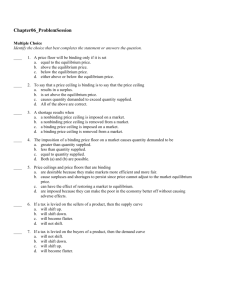HERE - Economics
advertisement

mono practice Multiple Choice Identify the choice that best completes the statement or answers the question. ____ 1. Which of the following is a characteristic of a natural monopoly? a. Average cost exceeds marginal cost over large regions of output. b. Increasing the number of firms increases each firm’s average total cost. c. One firm can supply output at a lower cost than two firms. d. All of the above are correct. ____ 2. Monopoly firms have a. downward-sloping demand curves and they can sell as much output as they desire at the market price. b. downward-sloping demand curves and they can sell only a limited quantity of output at each price. c. horizontal demand curves and they can sell as much output as they desire at the market price. d. horizontal demand curves and they can sell only a limited quantity of output at each price. ____ 3. For a monopoly, a. average revenue exceeds marginal revenue. b. average revenue equals marginal revenue. c. average revenue is less than marginal revenue. d. price equals marginal revenue. ____ 4. The monopolist's profit-maximizing quantity of output is determined by the intersection of which of the following two curves? a. marginal cost and demand b. marginal cost and marginal revenue c. average total cost and marginal revenue d. average variable cost and average revenue Figure 15-4 ____ 5. Refer to Figure 15-4. The demand curve for a monopoly firm is depicted by curve a. A. b. B. c. C. d. D. ____ 6. Refer to Figure 15-4. The marginal revenue curve for a monopoly firm is depicted by curve a. A. b. B. c. C. d. D. ____ 7. Refer to Figure 15-4. The marginal cost curve for a monopoly firm is depicted by curve a. A. b. B. c. C. d. D. ____ 8. Refer to Figure 15-4. The average total cost curve for a monopoly firm is depicted by curve a. A. b. B. c. C. d. D. ____ 9. Refer to Figure 15-4. If the monopoly firm is currently producing Q3 units of output, then a decrease in output will necessarily cause profit to a. remain unchanged. b. decrease. c. increase as long as the new level of output is at least Q2. d. increase as long as the new level of output is at least Q1. ____ 10. Refer to Figure 15-4. Profit can always be increased by increasing the level of output by one unit if the monopolist is currently operating at (i) Q0. (ii) Q1. (iii) Q2. (iv) Q3. a. b. c. d. (ii) only (i) or (ii) only (i) only (i), (ii), or (iii) only ____ 11. Refer to Figure 15-4. If the monopoly firm wants to maximize its profit, it should operate at a level of output equal to a. Q1. b. Q2. c. Q3. d. Q4. ____ 12. Refer to Figure 15-4. Profit will be maximized by charging a price equal to a. P1. b. P2. c. P3. d. P4. ____ 13. Refer to Figure 15-4. A profit-maximizing monopoly's total revenue is equal to a. P4 x Q2. b. P3 x Q4. c. (P4-P2) x Q2. d. (P4-P3) x Q2. ____ 14. The deadweight loss associated with a monopoly occurs because the monopolist a. maximizes profits. b. produces an output level less than the socially optimal level. c. produces an output level greater than the socially optimal level. d. equates marginal revenue with marginal cost. ____ 15. The economic inefficiency of a monopolist can be measured by the a. number of consumers who are unable to purchase the product because of its high price. b. excess profit generated by monopoly firms. c. poor quality of service offered by monopoly firms. d. deadweight loss. ____ 16. Monopolies are inefficient because they (i) eliminate barriers to entry. (ii) price their product at a level where marginal revenue exceeds marginal cost. (iii) restrict output below the socially efficient level of production. a. b. c. d. (i) and (ii) only (ii) and (iii) only (iii) only (i), (ii), and (iii) Figure 15-8 ____ 17. Refer to Figure 15-8. To maximize total surplus, a benevolent social planner would choose which of the following outcomes? a. 100 units of output and a price of $10 per unit b. 150 units of output and a price of $10 per unit c. 150 units of output and a price of $15 per unit d. 200 units of output and a price of $10 per unit ____ 18. Refer to Figure 15-8. To maximize its profit, a monopolist would choose which of the following outcomes? a. 100 units of output and a price of $10 per unit b. 100 units of output and a price of $20 per unit c. 150 units of output and a price of $15 per unit d. 200 units of output and a price of $20 per unit ____ 19. Refer to Figure 15-8. The monopolist's maximum profit a. is $800. b. is $1,000. c. is $1,250. d. cannot be determined from the diagram. ____ 20. Refer to Figure 15-8. The deadweight loss caused by a profit-maximizing monopoly amounts to a. $150. b. $200. c. $250. d. $500. Figure 15-11 ____ 21. Refer to Figure 15-11. If the monopoly firm is not allowed to price discriminate, then consumer surplus amounts to a. $0. b. $500. c. $1,000. d. $2,000. ____ 22. Refer to Figure 15-11. If the monopoly firm perfectly price discriminates, then consumer surplus amounts to a. $0. b. $250. c. $500. d. $1,000. ____ 23. Refer to Figure 15-11. If the monopoly firm is not allowed to price discriminate, then the deadweight loss amounts to a. b. c. d. $50. $100. $500. $1,000. ____ 24. Refer to Figure 15-11. If the monopoly firm perfectly price discriminates, then the deadweight loss amounts to a. $0. b. $100. c. $200. d. $500. ____ 25. Refer to Figure 15-11. If there are no fixed costs of production, monopoly profit without price discrimination equals a. $500. b. $1,000. c. $2,000. d. $4,000. ____ 26. Refer to Figure 15-11. If there are no fixed costs of production, monopoly profit with perfect price discrimination equals a. $500. b. $1,000. c. $2,000. d. $4,000. ____ 27. Since natural monopolies have a declining average cost curve, regulating natural monopolies by setting price equal to marginal cost would a. cause the monopolist to operate at a loss. b. result in a less than optimal total surplus. c. maximize producer surplus. d. result in higher profits for the monopoly. mono practice Answer Section MULTIPLE CHOICE 1. ANS: NAT: MSC: 2. ANS: NAT: 3. ANS: NAT: MSC: 4. ANS: NAT: MSC: 5. ANS: NAT: MSC: 6. ANS: NAT: MSC: 7. ANS: NAT: MSC: 8. ANS: NAT: MSC: 9. ANS: NAT: MSC: 10. ANS: NAT: MSC: 11. ANS: NAT: MSC: 12. ANS: NAT: MSC: 13. ANS: NAT: MSC: 14. ANS: NAT: MSC: 15. ANS: NAT: D Analytic Definitional B Analytic A Analytic Definitional B Analytic Interpretive A Analytic Interpretive B Analytic Interpretive C Analytic Interpretive D Analytic Interpretive C Analytic Analytical B Analytic Analytical B Analytic Analytical D Analytic Analytical A Analytic Analytical B Analytic Interpretive D Analytic PTS: 1 LOC: Monopoly DIF: 2 REF: 15-1 TOP: Natural monopoly PTS: LOC: PTS: LOC: DIF: TOP: DIF: TOP: 1 Monopoly 1 Monopoly 2 REF: 15-2 Monopoly MSC: Interpretive 1 REF: 15-2 Marginal revenue PTS: 1 LOC: Monopoly DIF: 2 REF: 15-2 TOP: Profit maximization PTS: 1 LOC: Monopoly DIF: 1 REF: 15-2 TOP: Demand curve PTS: 1 LOC: Monopoly DIF: 2 REF: 15-2 TOP: Marginal revenue PTS: 1 LOC: Monopoly DIF: 2 REF: 15-2 TOP: Marginal cost PTS: 1 LOC: Monopoly DIF: 2 REF: 15-2 TOP: Average total cost PTS: 1 LOC: Monopoly DIF: 2 REF: 15-2 TOP: Profit maximization PTS: 1 LOC: Monopoly DIF: 2 REF: 15-2 TOP: Profit maximization PTS: 1 LOC: Monopoly DIF: 2 REF: 15-2 TOP: Profit maximization PTS: 1 LOC: Monopoly DIF: 2 REF: 15-2 TOP: Profit maximization PTS: 1 LOC: Monopoly DIF: 2 REF: 15-2 TOP: Total revenue PTS: 1 LOC: Monopoly DIF: 2 REF: 15-3 TOP: Deadweight loss PTS: 1 LOC: Monopoly DIF: 2 REF: 15-3 TOP: Deadweight loss MSC: 16. ANS: NAT: 17. ANS: NAT: MSC: 18. ANS: NAT: MSC: 19. ANS: NAT: 20. ANS: NAT: MSC: 21. ANS: NAT: MSC: 22. ANS: NAT: MSC: 23. ANS: NAT: MSC: 24. ANS: NAT: MSC: 25. ANS: NAT: 26. ANS: NAT: 27. ANS: NAT: MSC: Interpretive C Analytic C Analytic Analytical B Analytic Analytical D Analytic C Analytic Applicative C Analytic Applicative A Analytic Analytical D Analytic Applicative A Analytic Analytical C Analytic D Analytic A Analytic Interpretive PTS: LOC: PTS: LOC: 1 Monopoly 1 Monopoly DIF: TOP: DIF: TOP: 2 REF: 15-3 Monopoly MSC: Interpretive 2 REF: 15-3 Total surplus PTS: 1 LOC: Monopoly DIF: 2 REF: 15-3 TOP: Profit maximization PTS: LOC: PTS: LOC: DIF: TOP: DIF: TOP: 1 Monopoly 1 Monopoly 2 REF: 15-3 Profit MSC: Analytical 2 REF: 15-3 Deadweight loss PTS: 1 LOC: Monopoly DIF: 2 REF: 15-4 TOP: Consumer surplus PTS: 1 LOC: Monopoly DIF: 2 REF: 15-4 TOP: Perfect price discrimination PTS: 1 LOC: Monopoly DIF: 3 REF: 15-4 TOP: Deadweight loss PTS: 1 LOC: Monopoly DIF: 2 REF: 15-4 TOP: Perfect price discrimination PTS: LOC: PTS: LOC: PTS: LOC: DIF: TOP: DIF: TOP: DIF: TOP: 1 Monopoly 1 Monopoly 1 Monopoly 3 REF: 15-4 Profit MSC: Applicative 3 REF: 15-4 Profit MSC: Applicative 2 REF: 15-5 Regulation | Natural monopoly







